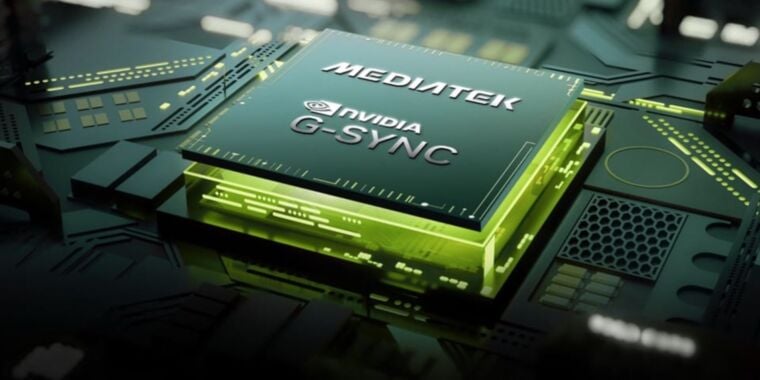Back in 2013, Nvidia introduced a new technology called G-Sync to eliminate screen tearing and stuttering effects and reduce input lag when playing PC games. The company accomplished this by tying your display’s refresh rate to the actual frame rate of the game you were playing, and similar variable refresh-rate (VRR) technology has become a mainstay even in budget monitors and TVs today.
The issue for Nvidia is that G-Sync isn’t what has been driving most of that adoption. G-Sync has always required extra dedicated hardware inside of displays, increasing the costs for both users and monitor manufacturers. The VRR technology in most low-end to mid-range screens these days is usually some version of the royalty-free AMD FreeSync or the similar VESA Adaptive-Sync standard, both of which provide G-Sync’s most important features without requiring extra hardware. Nvidia more or less acknowledged that the free-to-use, cheap-to-implement VRR technologies had won in 2019 when it announced its “G-Sync Compatible” certification tier for FreeSync monitors. The list of G-Sync Compatible screens now vastly outnumbers the list of G-Sync and G-Sync Ultimate screens.
Open standards always win. Just buy FreeSync and get an AMD GPU.
They always win, unless they don’t. History is littered with examples of the freer standard losing to the more proprietary standard, with plenty of examples going the other way, too.
Openness is an advantage in some cases, but tight control can be an advantage in some other cases.
OpenGL 😞
Obsolete by Vulkan. Which is open-source.
Up until relatively recently, it was great to see that Vulkan and DX12 were in a practically even split.
Still great to see that some of the best talent in terms of visual fideltiy showcases Vulkan, like rdr2 (originally defaulted to dx12, now vulkan), doom eternal and so on. Fully expect the next GTA to.
stadia was derp but it forced interested publishers to get acquainted with vk. I think it ended up doing more good for the industry in the end as a failure, rather than harm by succeeding and locking subscribers into such a restrictive game “ownership” paradigm.
OpenGL is a bit more complicated since it’s more than just a specification in practical terms. The documentation and tooling for OpenGL was really awful compared to Direct3D. This is a huge issue when developers are working on implementing features. For instance, the documentation for glReadPixels is incorrect for years and you would have to refer to the wiki for it instead. Yet, the only way you would know this is if you scoured the internet and happened to find a StackOverflow page asking about symptoms that may not even match your issue.
Thankfully, Vulkan seems to be a lot better in this regard but I still curse the heavens everytime I need to go back to OpenGL when supporting older hardware.
I’ll buy an AMD GPU once they have an answer to the 4090 (actually the 5090 at this point). I need AI upscaling, SDR-to-HDR conversion for videos, and way better ray tracing performance. Until that happens, my PC will unfortunately remain a mixed-breed bastard.
I need AI upscaling,
Not a hardware thing.
SDR-to-HDR conversion for videos,
Not a hardware thing.
and way better ray tracing performance.
Ray accelerators are a hardware thing. The AI to denoise them, again, not so much.
Just because AMD cards don’t come with tensor cores doesn’t mean they can’t run AI workloads, tensor cores are essentially cut-down GPU cores. They make sense in mobile devices to save on energy consumption but on desktop? Just use the TFLOPs you have for the basic matrix math you’re doing, the important bit, and that’s the gather/scatter memory architecture to deal with giant matrices, GPUs also have.
If there are software alternatives that allow me to automatically AI upscale and convert to HDR any video I play in any program, streaming or local (and it just works automatically in everything with no effort on my part), then please share download links with me. Until then I’ll stick with Nvidia GPUs.
“Any video in any program” is not how it works for you right now, either. And if you need something, then definitely not in every program but in your video editor because you’re a professional.
As to software: I’m on Linux. You won’t get that nvidia software there, either, in Linux land everyone gets those features because they have nothing to do with what GPU you have. Well at least mpv does it all, natively or via standard plugins (also AI frame interpolation), TBH I don’t really care how firefox plays videos as long as VRR works, which it does.
Ok 0.01%
Do you honestly believe that only 0.01% of PC users have an HDR monitor? Give me a break.
Awwwwwwwww… poor nVidia loses again.
This is silly.
Gsync solved a problem that couldn’t be solved before they made it. They stayed committed to that good solution until there was an alternative that reached a reasonable level of performance, then supported both until they could get close without the expensive extra hardware.
Was it worth it? For most people no. But it’s still technically superior today and there are loads of options without the extra cost.
VESA Adaptive-Sync goes back to the eDP stardard, 2009. AMD simply took that and said “Hey why aren’t we doing that over external DisplayPort”. And they did.
So instead of over-engineering a solution that nobody asked for to create vendor lock-in nobody (but fanboys with Stockholm Syndrome) want they exposed functionality that many many panels already had, anyway, because manufactures don’t use completely different control circuitry for laptop (eDP) and stand-alone monitors.
And, no, nvidia’s tech is not superior. From what I gather they have stricter certification requirements but that’s it.
Gsync modules have a lower sync window before LFC kicks in (usually around 30), and faster pixel response (overdrive) anywhere in the sync window. Those are benefits for both high framerate content and low framerate content.
Even today freesync usually bottoms out around 48. That constantly puts you at the LFC boundary for a lot of AAA games if youre on a popular midrange graphics card and aiming for 60fps average.
Just to address this from a high level, I see this as typical of Nvidia and AMD approaches. Nvidia makes something that’s engineered to perfection, but adds a bunch of requirements on it that make it expensive and supports vendor lock-in. Even if you’re willing to put with that to have The Best, you might hesitate when finding out what assholes Nvidia are about everything.
AMD then makes something 95% as good, and it’s cheap and you can work with them without yelling.
See also: FSR vs DLSS.
Is a problem that LFC is used? As it only duplicate frames.
When the framerate drops below the minimum refresh rate of the display, frames are duplicated and displayed multiple times so that they can sync to a refresh rate that is within the displays refresh rate range. For example, a display with a 60 – 144Hz refresh rate, would be able to sync the frames of a game running at 40 FPS, by doubling them so that the display could sync and run at 80 Hz. A display with LFC effectively results in the removal of the minimum refresh rate boundary.
https://www.amd.com/en/products/graphics/technologies/freesync.html
With constant frametime its fine, but games don’t have constant frametime which is the whole point of vrr in the first place.
That constantly puts you at the LFC boundary for a lot of AAA games if youre on a popular midrange graphics card and aiming for 60fps average.
That constantly puts you at the point where you should lower graphics settings. Average fps might be a thing to put on benchmarks, but for actual playing you want to go by minimum fps (non-cutscene if necessary). And it’s not like Adaptive Sync can’t go down that low, protocol-wise, it’s that monitor producers don’t care to.
Overdrive, too, is a matter of implementation not the sync protocol.
Part of the point of vrr for the end user is to simplify worrying about settings and your system performance, isnt it? The average person is gonna pick a graphics preset and play. If the game feels smooth off the rip, thats the preset theyll stick with. They arent going to make sure that the heaviest scenes stay above their LFC threshold. They don’t even know what half this shit means. And arguably they wont even notice LFC stutter in the first place, which is probably why, like you said, manufactures dont care to make the threshold lower.
To be clear though i agree with you. I do manage settings to keep my minimum where i like it. And having an older gsync chipped monitor which lets me put that minimum around 45fps is quite nice for path traced games and the like.
I also want to be able to replace this monitor someday and not lose that option.
The problem was solved by Nvidia, then AMD made it cheap and accessible and not requiring a dedicated hardware module.
For years and years Nvidia increased artificially by up to 150 euros many Gsync screens and for no legitimate reason. Initially there was NO compatibility with free sync at all.
Nvidia wasn’t kindly solving a gamers problem at least to after the first year of release of that tech. They were forcibly selling expensive hardware modules nobody needed or wanted. And long after freesync showed you could do it just as well without this expensive requirements.
This hardware module they insisted on selling wasn’t solving a technical problem but a money one.
I don’t even think anyone was ever able to differentiate between the different qualities of “sync techs”.
There absolutely was a legitimate reason. The hardware was not capable of processing the signals. They didn’t use FPGAs on a whim. They did it because they were necessary to handle the signals properly.
And you just haven’t followed the tech if you think they were indistinguishable. Gsync has supported a much wider variance of frame times over its entire lifespan.
Take notes, Apple Metal!
They could literally just transition to Vulkan with a Metal wrapper for pre-existing software ate any time but no, they have to keep their ecosystem locked down for some reason.
but no, they have to keep their ecosystem locked down for some reason
money 😘
TL:DR The stuff the dedicated module is doing will go inside specific Mediatek chips on specific premium monitors
Really weird it’s taken this long - I remember reading that the modules were expensive and assumed it was just because they were early generations and Nvidia was still working things out
Weren’t they FPGAs?
Nvidia says it’s partnering with chipmaker MediaTek to build G-Sync capabilities directly into scaler chips that MediaTek is creating for upcoming monitors.
Meaning, the same in blue?
No. Nvidia will be licensing the designs to mediatek, who will build out the ASIC/silicon in their scaler boards. That solves a few different issues. For one, no FPGAs involved = big cost savings. For another, mediatek can do much higher volume than Nvidia, which brings costs down. The licensing fee is also going to be significantly lower than the combined BOM cost + licensing fee they currently charge. I assume Nvidia will continue charging for certification, but that may lead to a situation where many displays are gsync compatible and simply don’t advertise it on the box except on high end SKUs.
This is why I think eventually FSR will win over DLSS in the end, despite DLSS having better performance.
Nvidia solutions only get abandoned when a superior technology takes over. See PhysX.
I think it’s unlikely one of those techs “wins” at all. It’s relatively easy to support them all from a software perspective and so gamers will just use whichever corresponds to their GPU.
Unless something has changed recently you still have to submit builds to Nvidia to have them train the DLSS kernel for you, so FSR is substantially easier to integrate.
Quick, sell all your Nvidia stocks!
haha. I wouldn’t, but yes please sell your stocks. I will buy them. We still have a $300B inflow of AI shizzle (bubble) that goes into Nvidia.
Good for them if it help eliminate the mark up of displays advertising gsync ultimate. I have my doubts but it’d make sense if they’re no longer using dedicated boards with FPGAs and RAM.
One has to wonder if VESA will further their VRR standard to support refresh rates as low as 1Hz
I’m not aware of any protocol limitations there, it’s just that monitors don’t bother to support refresh rates that low.
Experience at low frame rates will be choppy anyways, if it’s a fixed low framerate you can use LFC without quality degradation (say for movies) and if it’s a variable low framerate (where LFC causes jitter)… you should be lowering your graphics settings to get better fps. Why spend extra engineering and hardware on a capability that won’t ever result in a good experience anyway?
…has it really come to this? From laughing at console people for their “cinematic FPS” to nvidia fanboys saying “my monitor supports lower framerates than yours”? Aren’t we supposed to brag about our displays (pointlessly) reaching haptic fps? (that’s be 1kHz btw).
Higher end phones have the capability to gear down to 1hz to save power on static representation. Would be nice to see that on notebook eDP and hell, even with dekstop monitors too.
Yeah it feels premature since so many freesync displays still only go to 48hz.
Maybe if the mediatek chip can go to 30hz then VESA will update.
I think below that range they can frame double (low framerate compensation LFC) to go as low as 24 FPS
Will the Mediatek modules also support VESA Adaptive Sync, or will they have fixed frame rate on AMD cards?
So I have two Acer monitors with the dedicated G-Sync hardware, are those compatible with AMD freensync? I think both displays predate AMD freesync though.
I’m curious now that I’ve switched to Linux I’m running into issues with my NVIDIA GPU and Wayland suspend/hibernate functionality.
So I have two Acer monitors with the dedicated G-Sync hardware, are those compatible with AMD freensync?
Have a look at the manual but I don’t think chances are good.
I’m curious now that I’ve switched to Linux I’m running into issues with my NVIDIA GPU and Wayland suspend/hibernate functionality.
Suspend/hibernate is iffy in general, doesn’t necessarily have to do anything with the GPU. You’ll need sufficient swap space and a BIOS which is playing nice. Aside from slogging through logs to see if anything throws particular errors you can try booting without nvidia drivers (plain VESA console if you have to) and trying to hibernate that.
Last time i looked up Freesync vs. V-Sync, Freesync was for frequencies below 60 Htz, no?
Iirc freesync (extreme/ultimate) works down to 48fps. I use it when playing in 4k since my card struggles to keep a locked 60fps at that resolution
It works down to whatever the implementation in the monitor supports which tends to be 40 or 48fps. There’s a minimum you have to support if you want the FreeSync sticker but in principle you could call it AdaptiveSync and only support down to 60 or such, or support everything down to 1fps (which doesn’t happen in practice) and still call it FreeSync, AMD doesn’t mind you exceeding specs.
I use freesync on my monitor between 48 and 144 hz.
The range depends on the specific monitor.
Freesync works at up to 120Hz on my TV (LG C1), the maximum refresh rate of the set. I’m particularly sensitive to screen tearing, and confirmed that it’s working by playing various PC games with a framerate limiter.
Guess i confused it with VRR?
Freesync is a form of VRR.
It works up to the max frequency of your monitor











